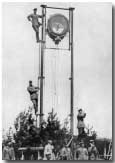Timeline - Introduction
 The Great War spanned four years and involved many nation states. This section illustrates the landmark events of the period 1914-19.
The Great War spanned four years and involved many nation states. This section illustrates the landmark events of the period 1914-19.
The sidebar to the right offers two views of the war's key events. The 'Timeline' offers a brief listing year by year, whereas 'On This Day' provides a summary of events for each and every day of the war and into 1919 - click the given month for details.
Sourced from the Chronology of the War, originally published between 1918-20, and drawn from contemporary sources by Edward Gleichen, the 'On This Day' entries provide a fascinating view of the war as it was viewed at the time.
The fact that the Chronology was written both during and in the immediate aftermath of the war means that it naturally suffers somewhat from a lack of distance. Modern perspectives - and access to wider archive sources - have altered perceptions of events as seen at the time.
Information on secret alliances, for example, were obviously not made widely available during the years 1914-18, but are important when judging events today.
Gleichen's Chronology perhaps suffers, too, from an Allied-centric view of the war. Whilst patently striving to be objective - many German and Austrian documentary sources were consulted during its compilation - the entries sometimes read as propaganda entries; for example, the entry for 1 July 1916 - the disastrous first day of the British Somme Offensive - makes no mention of the almost 60,000 casualties suffered by the British that day.
Rather, the chronology as a whole prefers instead to immerse itself in the facts of territorial gains (and losses), without paying close attention to the often painful cost of these.
But these are quibbles. No other chronology of such detail exists; and these entries are useful as a valuable source of contemporary perceptions of the war, albeit from the Allied perspective.
One in five of the Australians and New Zealanders who left their country to fight in the war never returned; 80,000 in total.
- Did you know?
